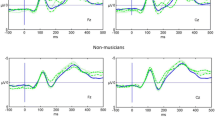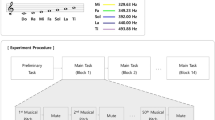We measured time parameters of the cognitive components in the auditory evoked potentials in professional musicians and non-musicians in order to determine electrophysiological correlates of the information processing rate and differentiation of the stimuli in such examined groups. It was found that the latencies of components N2 and Р3 were, on average, shorter in subjects that professionally practice music than those in non-musicians; at the same time, there were no differences between the peak-to-peak N2-P3 amplitudes in these groups. The revealed regularities can indicate that central processes of differentiation of auditory stimuli in musicians are realized more rapidly, and, correspondingly, the processing of the obtained information is quicker.
Similar content being viewed by others
Change history
29 October 2018
There was an error in the initials of one of the co-authors; the correct version is T. V. Kutsenko.
References
Y. C. Ho, MN. C. Cheung, and A. S. Chan, “Music training improves verbal but not visual memory: crosssectional and longitudinal explorations in children,” Neuropsychology, 17, No. 3, 439-450 (2003).
E. M. George and D. Coch, “Music training and working memory: An ERP study,” Neuropsychologia, 49, No. 5, 1083-1094 (2011).
A. Parbery-Clark, E. Skoe, C. Lam, and N. Kraus, “Musician enhancement for speech-in-noise,” Ear Hear., 30, No. 6, 653-661 (2009).
M. S. Franklin, K. Sledge Moore, C. Yip, et al., “The effects of musical training on verbal memory,” Psychol. Music, 36, No. 3, 353-365 (2008).
L. L. Patston, S. L. Hogg, amd L. J. Tippett, “Attention in musicians is more bilateral than in non-musicians,” Laterality, 12, No. 3, 262-272 (2007).
M. F. Gardiner, A. Fox, F. Knowles, and D. Jeffrey, “Learning improved by arts training,” Nature, 381, No. 6580, 284 (1996).
J. M. Cheek and L. R. Smith, “Music training and mathematics achievement,” Adolescence, 34, No. 136, 759-761 (1999).
A. B. Graziano, M. Peterson, and G. L. Shaw, “Enhanced learning of proportional math through music training and spatial-temporal training,” Neurol. Res., 21, No. 2, 139-152 (1999).
M. E. Nering, “The effect of piano and music instruction on intelligence of monozygotic twins,” Dissertation Abstracts, International Section A: Humanities and Social Sciences, 63, No. 3-A, 812 (2002).
E. G. Schellenberg, “Music lessons enhance IQ,” Psychol. Sci., 15, No. 8, 511-514 (2004).
Y. Lee, M. Lu, and H. Ko, “Effects of skill training on working memory capacity,” Learn. Instruct., 17, 336-344 (2007).
D. L. Strait, N. Kraus, A. Parbery-Clark, and R. Ashley, “Musical experience shapes top-down auditory mechanisms: Evidence from masking and auditory attention performance,” Hear. Res., 261, Nos. 1–2, 22-29 (2010).
A. G. Okhrei, T. V. Kutsenko, and M. Yu. Makarchuk, “Performance of working memory of musicians and nonmusicians in tests with letters, digits, and geometrical shapes,” Biologija, 62, No. 4, 207-215 (2016).
A. G. Okhrei, T. V. Kutsenko, and M. Yu. Makarchuk, “Performance of the Stroop test with estimation of spatial localization of stimuli by musicians and nonmusicians,” Visn. Cherkas. Univ., No. 1, 82-89 (2016).
A. G. Okhrei, T. V. Kutsenko, and M. Yu. Makarchuk, “Effects of music training on the performance of direct and reverse Stroop tests,” Visn. Taras Shevchenko Kyiv Natl. Univ., No. 21, 14-18 (2016).
R. Brochard, A. Dufour, and O. Després, “Effect of musical expertise on visuospatial abilities: Evidence from reaction times and mental imagery,” Brain Cognit., 54, 103-109 (2004).
L. L. Patston, “Balanced brains: An investigation of visuospatial ability and lateralization in musicians,” Thesis submitted in partial fulfillment of the requirements of the degree of Doctor of Philosophy in Psychology, Auckland (2007).
В V. V. Gnezditskii, Evoked Brain Potentials in Clinical Practice [in Russian], Publ. House of the TRTU, Taganrog (1997).
S. H. Patel and P. N. Azzam, “Characterization of N200 and P300: Selected studies of the event-related potential,” Int. J. Med. Sci., 2, 147-154 (2005).
J. Polich, “Updating P300: An integrative theory of P3a and P3b,” Clin. Neurophysiol., 118, 2128-2148 (2007).
A. G. Okhrei, T. V. Kutsenko, and M. Yu. Makarchuk, “Specificity of auditory cognitive evoked potentials in musicians,” Neurophysiology, 43, No. 6, 507-509 (2011).
J. Polich and A. Kok, “Cognitive and biological determinants of P300: an integrative review,” Biol. Psychol., 41, No. 2, 103-146 (1995).
J. Polich, L. Howard, and A. Starr, “P300 latency correlates with digits pan,” Psychophysiology, 20, No. 6, 665-670 (1983).
D. A. Nikjeh, J. J. Lister, and S. A. Frisch, “Hearing of note: An electrophysiologic and psychoacoustic comparison of pitch discrimination between vocal and instrumental musicians,” Psychophysiology, 45, No. 6, 994-1007 (2008).
L. Trainor, R. Desjardins, and C. Rockel,“A comparison of contour and interval processing in musicians and nonmusicians using event-related potentials,” Aust. J. Psychol., 51, No. 3, 147-153 (1999).
M. Besson and F. Faïta, “An event-related potential (ERP) study of musical expectancy: Comparison of musicians with nonmusicians”, J. Exp. Psychol. Human Percept. Perform., 21, No. 6, 1278-1296 (1995).
E. Genç, N. Yağişan, E. Apaydin Doğan, and B. O. Genç, “Effect of musical training on auditory event-related potentials N200 (mismatch negativity) and P300,” Turk. Klinikleri J. Med. Sci., 29, No. 1, 104-109 (2009).
C. Faßhauer, A. Frese, and S. Evers, “Musical ability is associated with enhanced auditory and visual cognitive processing,” BMC Neurosci., 16, 59 (2015).
Author information
Authors and Affiliations
Corresponding author
Rights and permissions
About this article
Cite this article
Okhrei, A.G., Kutsenko, N.V. & Makarchuk, N.Y. Parameters of Components N2 and P3 of the Auditory Cognitive Evoked Potentials in Musicians and Non-musicians. Neurophysiology 50, 203–208 (2018). https://doi.org/10.1007/s11062-018-9738-y
Received:
Published:
Issue Date:
DOI: https://doi.org/10.1007/s11062-018-9738-y




